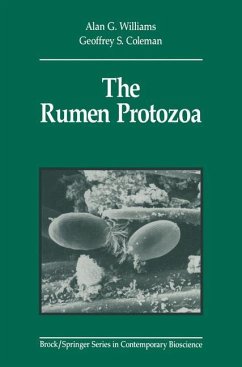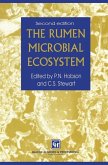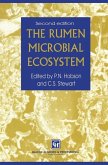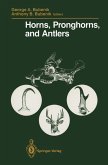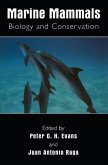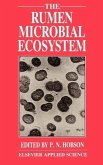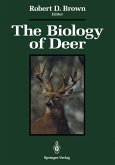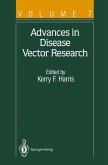- Broschiertes Buch
- Merkliste
- Auf die Merkliste
- Bewerten Bewerten
- Teilen
- Produkt teilen
- Produkterinnerung
- Produkterinnerung
All ruminants are dependent on the microorganisms that live in their forestomach - the rumen - to break down ingested feed constituents into a form that the host animal can utilize. Protozoa are part of this complex ruminal population and are essential for the nutritional well-being and productivity of the host ruminant. Over 30 different genera (nearly 300 species) of protozoa from the rumen ecosystem have been described since their initial discovery nearly 150 years ago. This book brings together, for the first time, the available information on these protozoa. It comprehensively describes…mehr
Andere Kunden interessierten sich auch für
![The Rumen Microbial Ecosystem The Rumen Microbial Ecosystem]() P.N. Hobson / C.S. Stewart (Hgg.)The Rumen Microbial Ecosystem231,99 €
P.N. Hobson / C.S. Stewart (Hgg.)The Rumen Microbial Ecosystem231,99 €![The Rumen Microbial Ecosystem The Rumen Microbial Ecosystem]() The Rumen Microbial Ecosystem224,99 €
The Rumen Microbial Ecosystem224,99 €![Horns, Pronghorns, and Antlers Horns, Pronghorns, and Antlers]() Horns, Pronghorns, and Antlers112,99 €
Horns, Pronghorns, and Antlers112,99 €![Marine Mammals Marine Mammals]() Peter G.H. Evans / Juan Antonio Raga (Hgg.)Marine Mammals67,99 €
Peter G.H. Evans / Juan Antonio Raga (Hgg.)Marine Mammals67,99 €![Rumen Microbial Ecosystem Rumen Microbial Ecosystem]() P.N. Hobson / C.S. Stewart (Hgg.)Rumen Microbial Ecosystem229,99 €
P.N. Hobson / C.S. Stewart (Hgg.)Rumen Microbial Ecosystem229,99 €![The Biology of Deer The Biology of Deer]() The Biology of Deer116,99 €
The Biology of Deer116,99 €![Advances in Disease Vector Research Advances in Disease Vector Research]() Advances in Disease Vector Research39,99 €
Advances in Disease Vector Research39,99 €-
-
-
All ruminants are dependent on the microorganisms that live in their forestomach - the rumen - to break down ingested feed constituents into a form that the host animal can utilize. Protozoa are part of this complex ruminal population and are essential for the nutritional well-being and productivity of the host ruminant. Over 30 different genera (nearly 300 species) of protozoa from the rumen ecosystem have been described since their initial discovery nearly 150 years ago. This book brings together, for the first time, the available information on these protozoa. It comprehensively describes the characteristic anatomical features of value for their identification and includes detailed sections on techniques and methodologies for the isolation and cultivation of these fastidious, oxygen-sensitive microorganisms. Their occurrence, biochemistry, physiology, and role in the ruminal ecosystem are fully reviewed. Particular emphasis is given to potential improvement of the nutrition and productivity of the host ruminant through manipulation of the protozoal population and its activities.
Hinweis: Dieser Artikel kann nur an eine deutsche Lieferadresse ausgeliefert werden.
Hinweis: Dieser Artikel kann nur an eine deutsche Lieferadresse ausgeliefert werden.
Produktdetails
- Produktdetails
- Brock Springer Series in Contemporary Bioscience
- Verlag: Springer / Springer New York / Springer, Berlin
- Artikelnr. des Verlages: 978-1-4612-7664-7
- Softcover reprint of the original 1st ed. 1992
- Seitenzahl: 460
- Erscheinungstermin: 19. September 2011
- Englisch
- Abmessung: 235mm x 155mm x 25mm
- Gewicht: 692g
- ISBN-13: 9781461276647
- ISBN-10: 1461276640
- Artikelnr.: 36115996
- Herstellerkennzeichnung
- Springer-Verlag GmbH
- Tiergartenstr. 17
- 69121 Heidelberg
- ProductSafety@springernature.com
- Brock Springer Series in Contemporary Bioscience
- Verlag: Springer / Springer New York / Springer, Berlin
- Artikelnr. des Verlages: 978-1-4612-7664-7
- Softcover reprint of the original 1st ed. 1992
- Seitenzahl: 460
- Erscheinungstermin: 19. September 2011
- Englisch
- Abmessung: 235mm x 155mm x 25mm
- Gewicht: 692g
- ISBN-13: 9781461276647
- ISBN-10: 1461276640
- Artikelnr.: 36115996
- Herstellerkennzeichnung
- Springer-Verlag GmbH
- Tiergartenstr. 17
- 69121 Heidelberg
- ProductSafety@springernature.com
Preface.- 1 Introduction.- 2 Identification and Classification of Entodiniomorphid Protozoa.- 2.1 Taxonomy of Entodiniomorphid Protozoa.- 2.2 The Genus Entodinium.- 2.3 The Genus Eodinium.- 2.4 The Genus Diplodinium.- 2.5 The Genus Eremoplastron.- 2.6 The Genus Eudiplodinium.- 2.7 The Genus Ostracodinium.- 2.8 The Genus Polyplastron.- 2.9 The Genus Metadinium.- 2.10 The Genus Epidinium.- 2.11 The Genus Enoploplastron.- 2.12 The Genus Ophryoscolex.- 2.13 The Genus Diploplastron.- 2.14 The Genus Elytroplastron.- 2.15 The Genus Epiplastron.- 2.16 The Genus Opisthotricum.- 2.17 The Genus Caloscolex.- 2.18 The Genus Rhinozeta.- 2.19 The Genus Parentodinium.- 2.20 Evolution of Entodiniomorphid Protozoa.- 3 The Holotrich Ciliates.- 3.1 Classification of the Rumen Holotrich Ciliates.- 3.2 Distribution of Holotrich Ciliates.- 3.3 Population Determinants.- 3.4 Species Description.- 3.5 Evolution of the Holotrich Ciliates.- 4 Methods Used for the Separation and Cultivation of Protozoa.- 4.1 Techniques for the Isolation of Ciliates from Rumen Contents.- 4.2 In situ Culture of Selected Protozoa.- 4.3 Cultivation of Entodiniomorphid Protozoa In vitro.- 4.4 Cultivation of Holotrich Ciliates In vitro.- 4.5 Continuous Culture Techniques.- 5 Association of Bacteria and Fungi with Rumen Ciliates.- 5.1 Intracellular Bacteria.- 5.2 Bacteria Attached to the Pellicle.- 5.3 Intracellular "Parasites" of Rumen Ciliates.- 6 Metabolism of Entodiniomorphid Protozoa.- 6.1 Metabolism of Starch.- 6.2 Metabolism of Cellulose and Cellobiose.- 6.3 Metabolism of Pectin, Hemicelluloses, and Related Compounds.- 6.4 Engulfment and Utilization of Bacteria.- 6.5 Engulfment and Utilization of Ovals and Fungi.- 6.6 Metabolism of Free Amino Acids.- 6.7 Metabolism of Protein.- 6.8 Sources of Amino Acids forProtozoal Growth.- 6.9 Metabolism of Free Constituents of Nucleic Acids.- 6.10 Metabolism of Lipids.- 6.11 Metabolism of Phospholipids.- 6.12 Metabolism of Lactic Acid.- 6.13 Uptake and Metabolism of Other Entodiniomorphid Protozoa.- Appendix: Techniques Used in Experiments on the Metabolism of Entodiniomorphid Protozoa.- 7 Structure of Entodiniomorphid Protozoa and Its Relationship to Function.- 7.1 General Description of Structure.- 7.2 Structure of Vestibular and Cytopharyngeal Regions.- 7.3 The Cilia and Infraciliature.- 7.4 The Paralabial Organelle.- 7.5 The Contractile Vacuoles.- 7.6 The Cytoproct (Rectum).- 7.7 The Pellicle (Cortex).- 7.8 The Boundary Between Ectoplasm and Endoplasm.- 7.9 Division of Entodiniomorphid Protozoa.- 7.10 Conjugation.- 7.11 Protozoal Chemotaxis and Feeding.- 7.12 Protozoal Metabolic Compartments.- 7.13 Rate of Clearance of Soluble and Particulate Materials.- 8 Metabolism of Holotrich Protozoa.- 8.1 Carbohydrate Metabolism.- 8.2 Oxygen Utilization.- 8.3 Nitrogen Metabolism.- 8.4 Lipid Metabolism.- 8.5 Metabolism of Nucleic Acids.- 9 Factors Affecting Protozoal Populations In vivo.- 9.1 Infection of Young Ruminants.- 9.2 Interrelationships Between Protozoal Species.- 9.3 Host Specificity.- 9.4 Geographical Distribution.- 9.5 Effect of Feed Composition.- 9.6 Diurnal Variation in Densities of Entodiniomorphid Protozoa.- 9.7 Seasonal Variation.- 10 Role of Protozoa in the Rumen.- 10.1 Metabolism of Cellulose and Hemicellulose.- 10.2 Metabolism of Starch.- 10.3 Metabolism of Bacteria.- 10.4 Metabolism of Protein.- 10.5 Effect of Protozoa on Rumen Metabolites.- 11 Effect of Ciliate Protozoa on the Productivity of the Host Ruminant.- 11.1 Post-Ruminal Digestion of Protozoa.- 11.2 Effect of Protozoa on Blood Metabolite Concentrations.- 11.3 Effect of Protozoa on Animal Growth.- 12 Protozoa and the Health of the Host Animal.- 12.1 Appearance of Animal.- 12.2 Detoxification.- 12.3 Lactic Acid Acidosis.- 12.4 Copper Toxicity.- 12.5 Bloat.- 13 The Flagellate Protozoa in the Rumen.- 13.1 Description and Classification.- 13.2 Infection of the Host and Population Density In vivo.- 13.3 Cultivation.- References.
Preface.- 1 Introduction.- 2 Identification and Classification of Entodiniomorphid Protozoa.- 2.1 Taxonomy of Entodiniomorphid Protozoa.- 2.2 The Genus Entodinium.- 2.3 The Genus Eodinium.- 2.4 The Genus Diplodinium.- 2.5 The Genus Eremoplastron.- 2.6 The Genus Eudiplodinium.- 2.7 The Genus Ostracodinium.- 2.8 The Genus Polyplastron.- 2.9 The Genus Metadinium.- 2.10 The Genus Epidinium.- 2.11 The Genus Enoploplastron.- 2.12 The Genus Ophryoscolex.- 2.13 The Genus Diploplastron.- 2.14 The Genus Elytroplastron.- 2.15 The Genus Epiplastron.- 2.16 The Genus Opisthotricum.- 2.17 The Genus Caloscolex.- 2.18 The Genus Rhinozeta.- 2.19 The Genus Parentodinium.- 2.20 Evolution of Entodiniomorphid Protozoa.- 3 The Holotrich Ciliates.- 3.1 Classification of the Rumen Holotrich Ciliates.- 3.2 Distribution of Holotrich Ciliates.- 3.3 Population Determinants.- 3.4 Species Description.- 3.5 Evolution of the Holotrich Ciliates.- 4 Methods Used for the Separation and Cultivation of Protozoa.- 4.1 Techniques for the Isolation of Ciliates from Rumen Contents.- 4.2 In situ Culture of Selected Protozoa.- 4.3 Cultivation of Entodiniomorphid Protozoa In vitro.- 4.4 Cultivation of Holotrich Ciliates In vitro.- 4.5 Continuous Culture Techniques.- 5 Association of Bacteria and Fungi with Rumen Ciliates.- 5.1 Intracellular Bacteria.- 5.2 Bacteria Attached to the Pellicle.- 5.3 Intracellular "Parasites" of Rumen Ciliates.- 6 Metabolism of Entodiniomorphid Protozoa.- 6.1 Metabolism of Starch.- 6.2 Metabolism of Cellulose and Cellobiose.- 6.3 Metabolism of Pectin, Hemicelluloses, and Related Compounds.- 6.4 Engulfment and Utilization of Bacteria.- 6.5 Engulfment and Utilization of Ovals and Fungi.- 6.6 Metabolism of Free Amino Acids.- 6.7 Metabolism of Protein.- 6.8 Sources of Amino Acids forProtozoal Growth.- 6.9 Metabolism of Free Constituents of Nucleic Acids.- 6.10 Metabolism of Lipids.- 6.11 Metabolism of Phospholipids.- 6.12 Metabolism of Lactic Acid.- 6.13 Uptake and Metabolism of Other Entodiniomorphid Protozoa.- Appendix: Techniques Used in Experiments on the Metabolism of Entodiniomorphid Protozoa.- 7 Structure of Entodiniomorphid Protozoa and Its Relationship to Function.- 7.1 General Description of Structure.- 7.2 Structure of Vestibular and Cytopharyngeal Regions.- 7.3 The Cilia and Infraciliature.- 7.4 The Paralabial Organelle.- 7.5 The Contractile Vacuoles.- 7.6 The Cytoproct (Rectum).- 7.7 The Pellicle (Cortex).- 7.8 The Boundary Between Ectoplasm and Endoplasm.- 7.9 Division of Entodiniomorphid Protozoa.- 7.10 Conjugation.- 7.11 Protozoal Chemotaxis and Feeding.- 7.12 Protozoal Metabolic Compartments.- 7.13 Rate of Clearance of Soluble and Particulate Materials.- 8 Metabolism of Holotrich Protozoa.- 8.1 Carbohydrate Metabolism.- 8.2 Oxygen Utilization.- 8.3 Nitrogen Metabolism.- 8.4 Lipid Metabolism.- 8.5 Metabolism of Nucleic Acids.- 9 Factors Affecting Protozoal Populations In vivo.- 9.1 Infection of Young Ruminants.- 9.2 Interrelationships Between Protozoal Species.- 9.3 Host Specificity.- 9.4 Geographical Distribution.- 9.5 Effect of Feed Composition.- 9.6 Diurnal Variation in Densities of Entodiniomorphid Protozoa.- 9.7 Seasonal Variation.- 10 Role of Protozoa in the Rumen.- 10.1 Metabolism of Cellulose and Hemicellulose.- 10.2 Metabolism of Starch.- 10.3 Metabolism of Bacteria.- 10.4 Metabolism of Protein.- 10.5 Effect of Protozoa on Rumen Metabolites.- 11 Effect of Ciliate Protozoa on the Productivity of the Host Ruminant.- 11.1 Post-Ruminal Digestion of Protozoa.- 11.2 Effect of Protozoa on Blood Metabolite Concentrations.- 11.3 Effect of Protozoa on Animal Growth.- 12 Protozoa and the Health of the Host Animal.- 12.1 Appearance of Animal.- 12.2 Detoxification.- 12.3 Lactic Acid Acidosis.- 12.4 Copper Toxicity.- 12.5 Bloat.- 13 The Flagellate Protozoa in the Rumen.- 13.1 Description and Classification.- 13.2 Infection of the Host and Population Density In vivo.- 13.3 Cultivation.- References.

